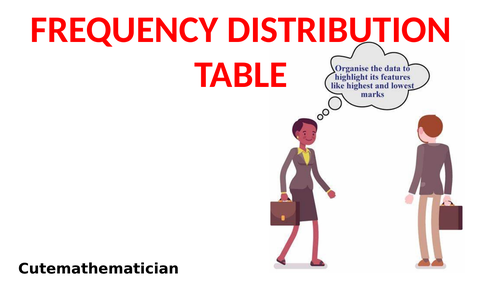
36Uploads
9k+Views
75Downloads
Mathematics
Sale

Histogram Powerpoint Presentation (PPT)/Lesson/ 19 Slides
The presentation contains 19 SLIDES:
Learning Objectives.
Definition of a Histogram.
Parts of a histogram.
Difference Between bar graph and histogram.
Types of intervals.
Tips for construction of bar graph.
Steps to construct bar graph with an example.
Read and Interpret a histogram.
Sale

Symmetry Powerpoint Presentation (PPT)/Lesson/ 22 Slides
The presentation contains 22 SLIDES:
Definition of symmetry.
Line of symmetry.
Symmetric figures.
Horizontal symmetry with examples
Vertical symmetry with examples
Diagonal symmetry with examples
Figures having two lines of symmetry with examples.
Figures having multiple lines of symmetry with examples
Translational symmetry with examples.
Rotational symmetry with examples.
Reflection symmetry with examples.
Glide symmetry with examples.
Sale

Double Bar Graph Powerpoint Presentation (PPT)/Lesson/ 22 Slides
The presentation contains 22 SLIDES:
Learning Objectives.
Definition of a double bar graph.
Parts of a double bar graph.
Difference between bar graph and double bar graph.
Tips for construction of double bar graph.
Steps to construct double bar graph with an example.
To read and interpret the double bar graph.
Sale

Direct and Inverse Variation Powerpoint Presentation (PPT)/Lesson/ 20 Slides
The presentation contains 20 SLIDES:
Definition of variation.
Types of variation.
Direct variation with example.
Inverse or indirect variation with example.
Sale

Pie Chart Powerpoint Presentation (PPT)/Lesson/ 20 Slides
The presentation contains 20 SLIDES:
Learning Objectives.
Definition of a Pie Chart.
Tips for construction of pie chart.
Steps to construct a pie chart with an example.
Scaling and drawing a pie chart.
Read and Interpret a pie chart.
Sale

Frequency Distribution Table Powerpoint Presentation (PPT)/Lesson/ 20 Slides
Contains 20 slides
**Objective: The student will be able to organize the given data to a meaningful and understandable.
**
The presentation contains:
Definition of a Frequency Distribution Table.
Types of Frequency Distribution Table:
a) Discrete Frequency Distribution Table (Ungrouped).
b) Continuous Frequency Distribution Table (Grouped).
Uses of Frequency Distribution Data.
5 steps to construct a Frequency Distribution Table with one example on ungrouped data and two examples on grouped data.
Steps include how to
Draw the table arrange columns
Fill in the data in the first column
Tallying the observations in the second column
Summing up in the third column.
Under Grouped data we have one example each on the types
Types of Grouped Data:
a) Continuous Interval Form (Exclusive Form). e.g. overlapping
b) Discontinuous Interval Form (Inclusive Form). e.g. non - overlapping
To understand in details the difference between two class intervals
overlapping
Non- overlapping
To know different terms with examples
Class interval
Lower class limit
Upper class limit
Width of class interval
Sale

Symmetry in Geometrical Shapes Powerpoint Presentation (PPT)/Lesson/ 31 Slides
Contains 31 slides
Objective: The student will be able to identify whether a given shape has symmetry, to draw the line of symmetry, how many lines of symmetry a shape can have and the type of symmetry the shape has like horizontal, vertical and diagonal.
The Presentation contains:
The symmetry, lines of symmetry and the types of lines of symmetry of the given geometrical shapes.
Examples of Triangles:
Scalene Triangle
Equilateral Triangle
Isosceles Triangle
Isosceles Right Triangle
Circle
Semicircle
Quadrilateral and its examples
Trapezoid
Isosceles Trapezoid
Right Trapezoid
Parallelogram
Rectangle
Rhombus
Square
Kite
One example each for an irregular and regular polygon.
Pentagon
Hexagon
Heptagon
Octagon
Nonagon
Decagon
Dodecagon
The formula for the number of lines of symmetry a regular polygon can have through observations from the previous examples.
Line
Angle
Sale

Profit and Loss Powerpoint Presentation (PPT)/Lesson/ 15 Slides
Contains 15 slides
The presentation contains:
Definition of the terms Selling price and Cost price.
Formula for Selling price and Cost price.
Overhead charges definition i.e. How to calculate the total cost.
Two solved examples each on application of selling price and cost price.
Formula for Profit percentage and Loss percentage.
5 real life solved problems on finding different parameters of the profit percentage and loss percentage.
e.g. 1)How to find the profit when the profit percentage and total cost price is given.
2) To find the gain or loss percentage when a cost price and a selling price is given.
3) To find the selling price when the cost price and lost percentage is given.
4) To find the loss percentage when the selling price and loss price is given.
5) To find the cost price when the selling price and the loss percentage is given.








